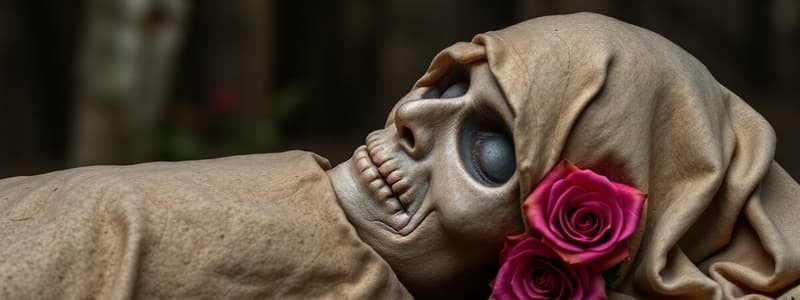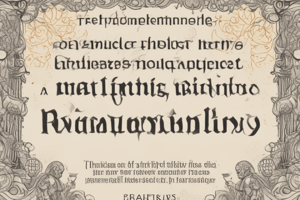Podcast
Questions and Answers
How does the concluding couplet of 'When I have fears that I may cease to be' alter the overall tone of the poem?
How does the concluding couplet of 'When I have fears that I may cease to be' alter the overall tone of the poem?
- It introduces a sense of acceptance and resignation, diminishing the significance of fame and love. (correct)
- It intensifies the anxiety about unfulfilled potential by emphasizing the speaker’s desperation.
- It shifts the focus to nature, illustrating how natural beauty can overcome the fear of death.
- It reinforces the speaker's artistic ambition, highlighting his devotion to poetry above all else.
In 'When I have fears that I may cease to be,' how does Keats' use of iambic pentameter contribute to the poem's overall effect?
In 'When I have fears that I may cease to be,' how does Keats' use of iambic pentameter contribute to the poem's overall effect?
- It establishes a strict, unyielding structure that emphasizes the inevitability of death.
- It provides a regular, underlying rhythm that adds a sense of balance and control to the speaker's emotional turmoil. (correct)
- It creates a choppy rhythm that mirrors the speaker's anxiety and fear.
- It allows for abrupt shifts in meter to reflect moments of epiphany and realization.
How does the imagery in the lines 'When I behold, upon the night’s starr’d face, / Huge cloudy symbols of a high romance' contribute to the poem’s central themes?
How does the imagery in the lines 'When I behold, upon the night’s starr’d face, / Huge cloudy symbols of a high romance' contribute to the poem’s central themes?
- It deepens the speaker’s anxiety about outliving his own creative potential.
- It symbolizes unrealized artistic potential and the unattainable beauty of the ideal. (correct)
- It conveys the speaker's desire to escape his earthly concerns through imagination.
- It highlights the speaker's fear of the vastness and uncertainty of the universe.
What is the most likely reason Keats uses the phrase 'fair creature of an hour' in the third quatrain?
What is the most likely reason Keats uses the phrase 'fair creature of an hour' in the third quatrain?
How does Keats' personal context influence the themes explored in 'When I have fears that I may cease to be'?
How does Keats' personal context influence the themes explored in 'When I have fears that I may cease to be'?
In 'When I have fears that I may cease to be,' what does the speaker mean when he refers to the 'magic hand of chance'?
In 'When I have fears that I may cease to be,' what does the speaker mean when he refers to the 'magic hand of chance'?
What is the significance of the transition from expressing fears to standing 'alone upon the shore' in the concluding couplet of 'When I have fears that I may cease to be'?
What is the significance of the transition from expressing fears to standing 'alone upon the shore' in the concluding couplet of 'When I have fears that I may cease to be'?
How does the structure of 'When I have fears that I may cease to be' as a Shakespearean sonnet enhance the poem's impact?
How does the structure of 'When I have fears that I may cease to be' as a Shakespearean sonnet enhance the poem's impact?
Flashcards
"When I have fears" Main Themes
"When I have fears" Main Themes
Fears of death, unfulfilled potential, and lost love.
"When I have fears" Structure
"When I have fears" Structure
14-line poem in iambic pentameter, with rhyme scheme ABAB CDCD EFEF GG.
First Quatrain Fear
First Quatrain Fear
Worry about dying before writing all he wants.
Second Quatrain Fear
Second Quatrain Fear
Signup and view all the flashcards
Third Quatrain Fear
Third Quatrain Fear
Signup and view all the flashcards
Concluding Couplet Meaning
Concluding Couplet Meaning
Signup and view all the flashcards
"Magic hand of chance"
"Magic hand of chance"
Signup and view all the flashcards
Overall Tone
Overall Tone
Signup and view all the flashcards
Study Notes
- John Keats wrote the poem "When I have fears that I may cease to be"
Main Theme
- The poem explores themes of mortality, the fear of dying before achieving his full potential as a writer, and the inability to experience love
Structure and Form
- It is a Shakespearean sonnet, consisting of 14 lines
- The poem follows the rhyme scheme ABAB CDCD EFEF GG
- It is written in iambic pentameter
- The poem is divided into three quatrains and a concluding couplet
First Quatrain
- The speaker expresses fear of dying before he has fully expressed his thoughts through writing
- He worries about his "high-piled books" becoming unwritten
Second Quatrain
- The speaker fears never beholding the night sky again; the "night's starred face"
Third Quatrain
- The speaker fears he may never experience the joy of love
- He thinks he might never again trace the "fair creature of an hour" which is a fleeting but beautiful love experience
Concluding Couplet
- The speaker says that his fears seem insignificant when he stands alone on the shore
- In such moments, fame and love lose their importance, becoming "nothing"
Language and Imagery
- The poem uses rich imagery, particularly visual imagery related to nature (harvest, stars) and the act of writing ("high-piled books")
- "Magic hand of chance" refers to fate and luck and how they influence events
- The poem has metaphorical language referring to books and the night sky
- "Fair creature of an hour" refers to a temporary but beautiful love
- The feeling of isolation is emphasized by "stand alone"
Tone
- The poem expresses a sense of anxiety and urgency
- The fear of unfulfilled potential drives the poem
- The tone shifts to acceptance and resignation in the couplet
Interpretation
- The poem reflects Keats’ awareness of his own mortality due to his declining health
- It showcases his devotion to poetry
- The poem presents a conflict between artistic ambition, love, and the limitations of human life
- The ending suggests he finds solace in nature and solitude
Context
- John Keats wrote the poem around 1818
- Keats knew that his life would be short
- Keats' personal experiences and struggles with illness influenced his work
Studying That Suits You
Use AI to generate personalized quizzes and flashcards to suit your learning preferences.
Description
This is a Shakespearean sonnet by John Keats expressing his fears of death, unfulfilled potential in writing, and the fleeting nature of love. The poem follows the rhyme scheme ABAB CDCD EFEF GG and delves into the speaker's anxieties about mortality and the brevity of life's experiences.



